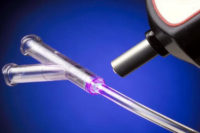ASSEMBLY Magazine recently asked Paul Chauvin, Vectra engineering manager at Ticona Technical Polymers (Summit, NJ), a few questions on plastic medical device trends, issues and challenges. Chauvin has decades of experience in injection molding, especially in the medical arena.
ASSEMBLY: What are the advantages of using plastic injection molding to manufacture medical device components?
Chauvin: Injection molding offers strong cost benefits, especially for large runs and when there is a need for great repeatability of a given geometry in complex parts.
ASSEMBLY: Why is plastic-injection molding more popular for medical devices today?
Chauvin: Injection molding is becoming more popular because of its cost effectiveness, and the high-quality parts it creates that eliminate secondary finishing and other operations.
ASSEMBLY: What are some typical medical device applications for plastic molding?
Chauvin: Injection molding is being used for a very wide range of components, including surgical instruments, dental devices, and key elements of diagnostic equipment of all kinds.
ASSEMBLY: What is the biggest trend in plastic injection molding today?
Chauvin: A major trend is to reduce the number of parts by combining multiple components into a single injection-molding element. This eliminates some downstream assembly steps and makes the entire manufacturing process more efficient.
ASSEMBLY: What is the biggest challenge to assembling components that are molded?
Chauvin: The need to move products through the assembly process economically is a key challenge. In part, this is being met through automation, which, of course, involves balancing added automation costs against time, labor and other savings.
ASSEMBLY: How does "moldability" affect the type of joining process used to assemble plastic components?
Chauvin: The joining processes used often depend on the nature of the polymer. For instance, Vectra liquid crystal polymer elements are usually joined by adhesives, ultrasonic welding and threaded inserts, but often have too high a modulus for snap fits. Joining methods are often combined. Snap fits may help align two parts, which are then firmly attached by ultrasonic welding.
ASSEMBLY: What design considerations must be considered when using plastic injection-molding technology?
Chauvin: The most knowledgeable companies design for the entire process up front, including manufacturability. They bring all parties that eventually will be involved in creating a component together at the start and consider all relevant aspects, from polymer selection, wall thickness and part geometry to moldability, gate placement, the molding machine and cycle time.
ASSEMBLY: What is the biggest mistake manufacturing engineers make with injection molding?
Chauvin: Engineers need to understand how changes in wall thickness affect a part. Too much variability in a component's walls can lead to a poor packing, the loss of key mechanical properties, warpage and other problems.
ASSEMBLY: What should engineers look for when evaluating or selecting molding equipment?
Chauvin: They should make sure the equipment selected will work well with the material selected; can handle the geometry of the part; and yield the required precision.

